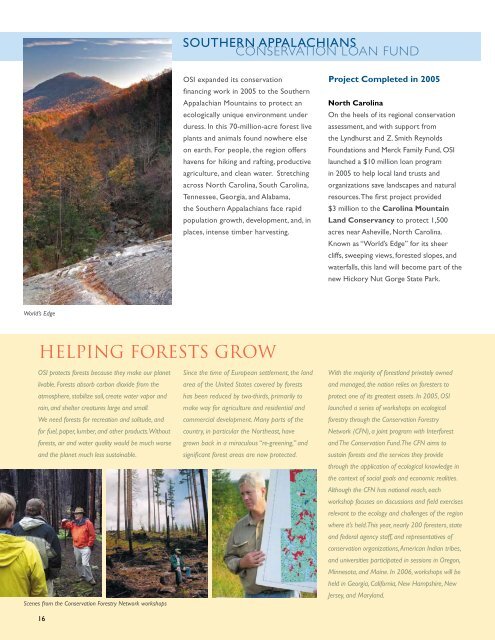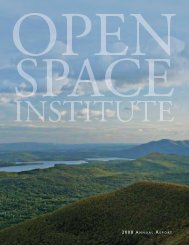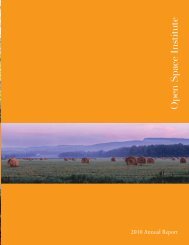OSI Annual Report 2005 - Open Space Institute
OSI Annual Report 2005 - Open Space Institute
OSI Annual Report 2005 - Open Space Institute
You also want an ePaper? Increase the reach of your titles
YUMPU automatically turns print PDFs into web optimized ePapers that Google loves.
World’s Edge<br />
16<br />
SOuTHERN APPALACHIANS<br />
CONSERVATION LOAN FUND<br />
<strong>OSI</strong> expanded its conservation<br />
financing work in 005 to the Southern<br />
Appalachian Mountains to protect an<br />
ecologically unique environment under<br />
duress. In this 70-million-acre forest live<br />
plants and animals found nowhere else<br />
on earth. For people, the region offers<br />
havens for hiking and rafting, productive<br />
agriculture, and clean water. Stretching<br />
across North Carolina, South Carolina,<br />
Tennessee, Georgia, and Alabama,<br />
the Southern Appalachians face rapid<br />
population growth, development, and, in<br />
places, intense timber harvesting.<br />
helping forests grow<br />
<strong>OSI</strong> protects forests because they make our planet<br />
livable. Forests absorb carbon dioxide from the<br />
atmosphere, stabilize soil, create water vapor and<br />
rain, and shelter creatures large and small.<br />
We need forests for recreation and solitude, and<br />
for fuel, paper, lumber, and other products. Without<br />
forests, air and water quality would be much worse<br />
and the planet much less sustainable.<br />
Scenes from the Conservation Forestry Network workshops<br />
Since the time of European settlement, the land<br />
area of the United States covered by forests<br />
has been reduced by two-thirds, primarily to<br />
make way for agriculture and residential and<br />
commercial development. Many parts of the<br />
country, in particular the Northeast, have<br />
grown back in a miraculous “re-greening,” and<br />
significant forest areas are now protected.<br />
Project Completed in <strong>2005</strong><br />
North Carolina<br />
On the heels of its regional conservation<br />
assessment, and with support from<br />
the Lyndhurst and Z. Smith Reynolds<br />
Foundations and Merck Family Fund, <strong>OSI</strong><br />
launched a $10 million loan program<br />
in 005 to help local land trusts and<br />
organizations save landscapes and natural<br />
resources.The first project provided<br />
$3 million to the Carolina Mountain<br />
Land Conservancy to protect 1,500<br />
acres near Asheville, North Carolina.<br />
Known as “World’s Edge” for its sheer<br />
cliffs, sweeping views, forested slopes, and<br />
waterfalls, this land will become part of the<br />
new Hickory Nut Gorge State Park.<br />
With the majority of forestland privately owned<br />
and managed, the nation relies on foresters to<br />
protect one of its greatest assets. In <strong>2005</strong>, <strong>OSI</strong><br />
launched a series of workshops on ecological<br />
forestry through the Conservation Forestry<br />
Network (CFN), a joint program with Interforest<br />
and The Conservation Fund. The CFN aims to<br />
sustain forests and the services they provide<br />
through the application of ecological knowledge in<br />
the context of social goals and economic realities.<br />
Although the CFN has national reach, each<br />
workshop focuses on discussions and field exercises<br />
relevant to the ecology and challenges of the region<br />
where it’s held. This year, nearly 200 foresters, state<br />
and federal agency staff, and representatives of<br />
conservation organizations, American Indian tribes,<br />
and universities participated in sessions in Oregon,<br />
Minnesota, and Maine. In 2006, workshops will be<br />
held in Georgia, California, New Hampshire, New<br />
Jersey, and Maryland.




